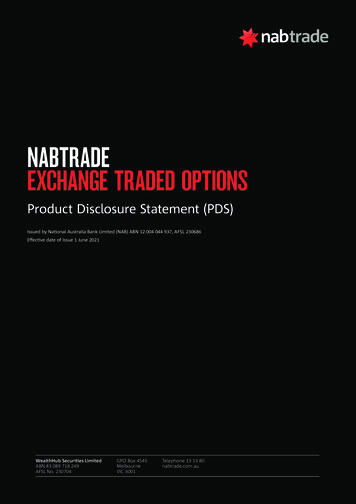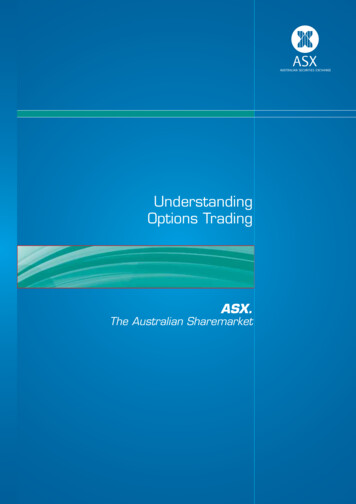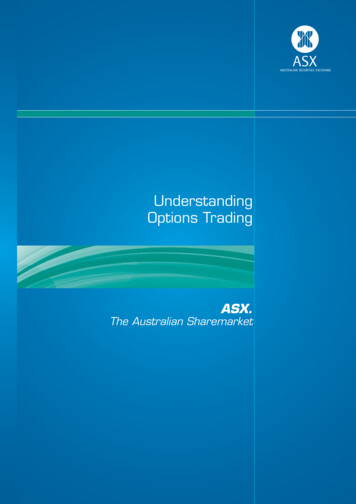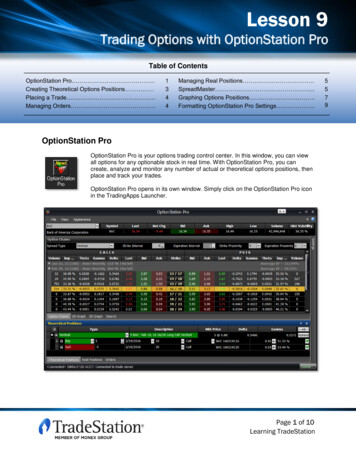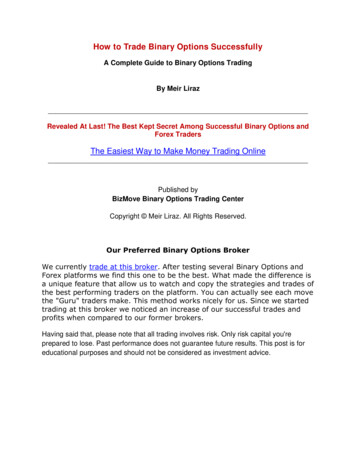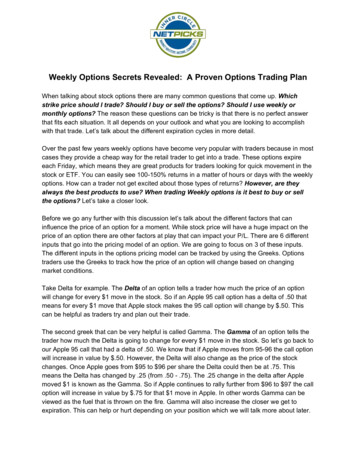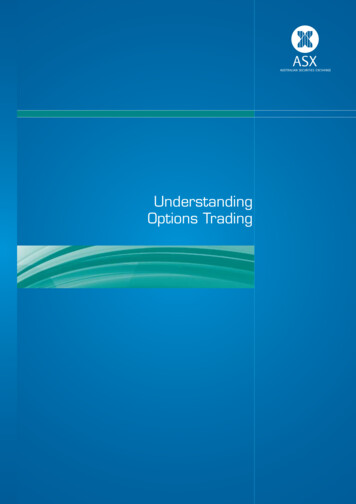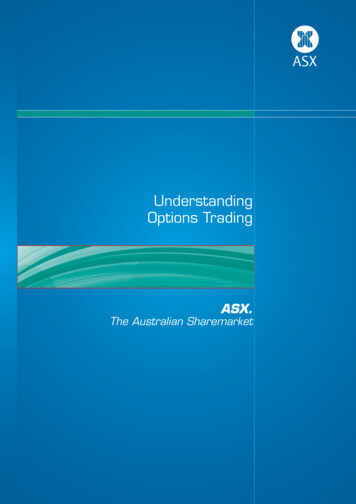
Transcription
UnderstandingOptions TradingASX.The Australian Sharemarket
Disclaimer of LiabilityInformation provided is for educational purposes and does not constitute financial product advice. Youshould obtain independent advice from an Australian financial services licensee before making any financialdecisions. Although ASX Limited ABN 98 008 624 691 and its related bodies corporate (“ASX”) hasmade every effort to ensure the accuracy of the information as at the date of publication, ASX does notgive any warranty or representation as to the accuracy, reliability or completeness of the information.To the extent permitted by law, ASX and its employees, officers and contractors shall not be liable forany loss or damage arising in any way (including by way of negligence) from or in connection with anyinformation provided or omitted or from any one acting or refraining to act in reliance on this information.SPAN is a registered trademark of Chicago Mercantile Exchange Inc., used herein under license. ChicagoMercantile Exchange Inc. assumes no liability in connection with the use of SPAN by any person or entity.No part of this Booklet may be copied, reproduced, published, stored in a retrieval system or transmittedin any form or by any means in whole or in part without the prior written permission of the ASX Group.For these product/s the market is operated by ASX Limited ACN 008 624 691.Edition 18 printed March 2015 Copyright 2015 ASX Limited ABN 98 008 624 691. All rights reserved 2015Exchange Centre, 20 Bridge Street, Sydney NSW 2000Telephone: 131 279www.asx.com.au
ContentsBefore you begin2Taxation16What is an option?3Tradeability17Call options3Put options4Advantages of option trading5Risk management5How can optionswork for you?18Time to decide5Speculation5Trading index options20Leverage5Diversification5How are index options different?20Income generation5Settlement method20Some key advantages oftrading index options21Option features6Examples of how trading indexoptions can work for you22The 5 components of an option contract61. Underlying securities/approved indices6Differences between equityoptions and index options232. Contract size63. Expiry day6Pay-off diagrams244. Exercise (or strike) price75. Premium7Call option taker24Call option writer24Put option taker25Put option writer25Summary26Risks of options trading27You and your broker28Your relationship with your broker28The paperwork: Client Agreement forms28Instructing a broker to trade options29Role of Market Makers30ASX Clear Pty Limited32Options information on the ASX web site33Glossary of terms35Option contract specifications37Further information38Adjustments to optioncontracts8Option pricing fundamentals9Intrinsic value9Call options9Put options9Time value10The role of dividends inpricing and early exercise10Parties to an option contract11The option taker11The option writer13Tracking positions and costs14How to track options positions14Costs14Margins155
Before you beginThe ASX options market has been operatingsince 1976. Since the market started, volumeshave increased significantly. There are nowover 60 different companies and the S&P ASX200 share price index to choose from. A list ofcompanies over which Exchange Traded Options(options) are traded can be found on the ASXwebsite, www.asx.com.au/options.This booklet explains the concepts of options,how they work and what they can be usedfor. It should be noted that this booklet dealsexclusively with Exchange Traded Options overlisted shares and indices, and not companyissued options. Information on other ASXproducts is available by calling 131 279 orvisiting www.asx.com.au. To assist in yourunderstanding there is a glossary of termson page 35.2Option sellers are referred to as ‘writers’ becausethey underwrite (or willingly accept) the obligationto deliver or accept the shares covered by anoption. Similarly, buyers are referred to as the‘takers’ of an option as they take up the right tobuy or sell a parcel of shares.Every option contract has both a taker (buyer)and a writer (seller). Options can provideprotection for a share portfolio, additionalincome or trading profits. Both the purchaseand sale of options, however, involve risk.Transactions should only be entered into byinvestors who understand the nature andextent of their rights, obligations and risks.
What is an option?An option is a contract between two partiesgiving the taker (buyer) the right, but notthe obligation, to buy or sell a securityat a predetermined price on or before apredetermined date. To acquire this right thetaker pays a premium to the writer (seller) ofthe contract.There are two types of options available:call options and put options.Call optionsCall options give the taker the right, but notthe obligation, to buy the underlying sharesat a predetermined price, on or before apredetermined date.For illustrative purposes, the term shares (orstock) is used throughout this booklet whenreferring to the underlying securities. Whenconsidering options over an index, the sameconcepts generally apply. From time to timeoptions may be available over other types ofsecurities.Call option exampleThe standard number of shares covered by oneoption contract on ASX is 100. However, thismay change due to adjustment events such asa new issue or a reorganisation of capital in theunderlying share.All of the examples in this booklet assume100 shares per contract and ignore brokerageand ASX fees. You will most definitely need toconsider these when evaluating an optiontransaction. For options over an index, thecontract value is based on a dollar value perpoint. Details can be checked in the contractspecifications.TAKER(BUYER)BROKERSantos Limited (STO) shares have a last saleprice of 8.00. An available 3 month optionwould be an STO 3 month 8.00 call. A takerof this contract has the right, but not theobligation, to buy 100 STO shares for 8.00per share at any time until the expiry*. For thisright, the taker pays a premium (or purchaseprice) to the writer of the option. In order totake up this right to buy the STO shares at thespecified price, the taker must exercise theoption on or before expiry.On the other hand, the writer of this call optionis obliged to deliver 100 STO shares at 8.00per share if the taker exercises the option. Foraccepting this obligation the writer receives andkeeps the option premium whether the optionis exercised or not.ASXBROKERWRITER(SELLER)It is important to note that the taker is not obligatedto exercise the option.* T he expiry day for stock options is usually the Thursday before the last Friday in the expiry month unless ASX Cleardetermines another day. This may change for various reasons (eg. for public holidays), so please check with your broker.For index options, refer to the contract specifications. Please be aware this may change from 2016 with some stockoptions migrating to expiry day being the third Thursday. Please check the ASX website or contact your broker.3
Put optionsPut options give the taker the right but notthe obligation to sell the underlying sharesat a predetermined price on or before apredetermined date. The taker of a put isonly required to deliver the underlying sharesif they exercise the option.Put option exampleAn available option would be an STO 3 month 8.00 put. This gives the taker the right, butnot the obligation, to sell 100 STO sharesfor 8.00 per share at any time until expiry.For this right, the taker pays a premium (orpurchase price) to the writer of the put option.In order to take up this right to sell the STOshares at a specified price the taker mustexercise the option on or before expiry. Thewriter of the put option is obliged to buy theSTO shares for 8.00 per share if the optionis exercised. As with call options, the writerof a put option receives and keeps the optionpremium whether the option is exercised or not.It is important to notethat the taker is notobligated to exercisethe option.If the call or put option is exercised, the sharesare traded at the specified price. This priceis called the exercise or strike price. The lastdate when an option can be exercised is calledexpiry day.There are two different exercise styles:American style, which means the option canbe exercised at any time prior to the expiry; andEuropean style, which means the option canonly be exercised on the expiry day. Most stockoptions traded on ASX are American style.RIGHTS AND OBLIGATIONS4CALL OPTIONTAKER(BUYER)Taker receives the right to buy shares at the exerciseprice in return for paying the premium to the writer.Writer receives and keeps premium butnow has the obligation to deliver sharesif the taker exercises.WRITER *(SELLER)PUT OPTION*TAKER(BUYER)Taker receives the right to sell shares at the exerciseprice in return for paying the premium to the writer.Writer receives and keeps premium butnow has the obligation to buy the underlying sharesif the taker exercises.* The taker of a put and writer of a call option do not have to own the underlying shares.WRITER(SELLER)
Advantages of option tradingRisk managementPut options, when taken, allow you to hedgeagainst a possible fall in the value of shares youhold.The table below compares the purchaseof 1 call option and 100 shares. Thehigher percentage return from the optiondemonstrates how leverage can work.OPTIONSTOCKBought on October 15 38 400Sold on December 15 67 450Profit 29 5076.3%12.5%Time to decideBy taking a call option, the purchase pricefor the shares is locked in. This gives the calloption holder until the expiry day to decidewhether or not to exercise the option and buythe shares. Likewise the taker of a put optionhas time to decide whether or not to sellthe shares.SpeculationThe ease of trading in and out of an optionposition makes it possible to trade optionswith no intention of ever exercising them.If you expect the market to rise, you maydecide to buy call options. If you expect a fall,you may decide to buy put options.Either way you can sell the option prior toexpiry to take a profit or limit a loss.LeverageLeverage provides the potential to make ahigher return from a smaller initial outlay thaninvesting directly. However, leverage usuallyinvolves more risks than a direct investmentin the underlying shares. Trading in optionscan allow you to benefit from a change in theprice of the share without having to pay the fullprice of the share. The following example helpsillustrate how leverage can work for you.Return on investment(not annualised)DiversificationOptions can allow you to build a diversifiedportfolio for a lower initial outlay thanpurchasing shares directly.Income generationYou can earn extra income over and abovedividends by writing call options against yourshares, including shares bought using a marginlending facility. By writing an option you receivethe option premium up front. While you get tokeep the option premium, there is a possibilitythat you could be exercised against and have todeliver your shares at the exercise price.It is important that you balance the advantagesof trading options with the risks before makingany decisions. Details of the risks of optionstrading are set out on page 27.5
Option featuresThe ease of trading in and out of optionson ASX‘s options market is assisted by thestandardisation of the following option contractcomponents:1. Underlying securities2. Contract size3. Expiry day4. Exercise pricesThere is a fifth component, the optionpremium, which is not standardised butrather determined by market forces. ASXoperates the options market, while ASX ClearPty Limited (ASX Clear) operates the clearingfacility for ASX‘s options market. AmongASX‘s responsibilities is the setting of thestandardised option components.1 option contractusually represents 100underlying shares.6The 5 components of an optioncontract1. Underlying securities/approved indicesOptions traded on ASX‘s options market areonly available for certain securities and the S&PASX 200 share price index. These securitiesare referred to as underlying securities orunderlying shares. They must be listed on ASXand are selected by ASX Clear according tospecific guidelines. The issuers of underlyingsecurities do not participate in the selection ofsecurities against which options may be listed.Calls and puts over the same underlyingsecurity are termed classes of options.For example, all call and put options listedover Lend Lease Corporation (LLC) shares,regardless of exercise price and expiryday, form one class of option. A list of allthe classes of options trading on ASX‘soptions market can be found on the ASXwebsite www.asx.com.au/options (in the‘Related information’ section on the ‘Volatilityparameters and ETO class rankings’ page).2. Contract sizeOn ASX‘s options market an option contractsize is standardised at 100 underlying shares.That means, 1 option contract represents 100underlying shares. As mentioned earlier, thismay change if there is an adjustment such as anew issue or a reorganisation of capital in theunderlying share. In the case of index options,contract value is fixed at a certain number ofdollars per index point (for example, 10 perindex point). The size of the contract is equal tothe index level x the dollar value per index point(for example, for an index at 4,500 points, 1contract would be 4,500 x 10 45,000).3. Expiry dayOptions have a limited life span and expire onstandard expiry days set by ASX Clear. Theexpiry day is the day on which all unexercisedoptions in a particular series expire and is thelast day of trading for that particular series.For options over shares this is usually theThursday before the last Friday in the month.*For index options, expiry is usually the thirdThursday of the contract month. ASX will alsolist weekly index options with the next two tothree weeks available, expiry day is Thursday.However, ASX Clear has the right to changethis date should the need arise.As options expire new expiry months are addedfurther out.All option classes (stock or index) have expiriesbased on the financial quarters (March, June,September and December).For example, a June expiry means that theoption expires on the expiry day in June. IfThursday or Friday are not business days,the expiry day is brought forward to the nextbusiness day.A full list of all options series available fortrading is available on the ASX website,www.asx.com.au/options in the csv file‘Listed ETO code list’ in the ‘Related information’section. This list is updated daily.* Please be aware this may change from 2016 with some stock options migrating to expiry day being the third Thursday.Please check the ASX website or contact your broker.
You can find a useful expiry calendar on theASX website: www.asx.com.au/options under“Expiry calendar” in the ‘Quick links’ section.For detail on option listing guidelines pleaseview the “Option listing guidelines.pdf” on theASX website: www.asx.com.au/options in the“Quick links” section.4. Exercise (or strike) pricesThe exercise price is the predetermined buyingor selling price for the underlying shares if theoption is exercised.ASX Clear sets the exercise prices for alloptions listed on ASX‘s options market with arange of exercise prices available for options onthe same expiry. New exercise prices are listedas the underlying share price moves.For example, if the underlying share is tradingat 3.50, it is likely that option contractswith the following strike prices would be listed: 3.00, 3.25, 3.50, 3.75 and 4.00.A range of exercise prices allows you to moreeffectively match your expectations of the pricemovement in the underlying share to youroption position. Exercise prices may also beadjusted during the life of the option if thereis a new issue or a reorganisation of capitalin the underlying shares.5. PremiumThe premium is the price of the option whichis arrived at by the negotiation between thetaker and the writer of the option. It is the onlycomponent of the five option components thatis not set by ASX Clear.Option premiums are quoted on a cents pershare basis. To calculate the full premiumpayable for a standard size option contract,multiply the quoted premium by the numberof shares per contract, usually 100.For example, a quoted premium of 16 centsrepresents a total premium cost of 16.00( 0.16 x 100) per contract. To calculatethe full premium payable for an index option,you simply multiply the premium by theindex multiplier. For example, a premium of30 points, with an index multiplier of 10,represents a total premium cost of 300per contract.No eligibility for dividends and votingThe taker of the call option or the writer ofa put option does not receive dividends onthe underlying shares until the shares aretransferred after exercise. Nor do they obtainany voting rights in relation to the shares untilthat time.Option information isavailable on our websitewww.asx.com.au7
Adjustments to option contractsThe specifications of option contracts listedon ASX‘s options market are standardised asmuch as possible.However, ASX may make adjustments tooptions to preserve, as far as practicable, thevalue of positions in options held by takers andwriters. Adjustments are made as a result ofcorporate events that affect the price of theunderlying, such as a bonus issue, share splitor rights issue.Adjustments may be made to one or more ofthe components of an option, including exerciseprice, contract size, underlying securities, andnumber of contracts. With some events, ASXhas adopted adjustments which are understoodby the market to be conventions that willgenerally be applied when those circumstancesarise. Specific adjustments are set out in theASX Operating Rules.8The adjustment assumes that the corporateevent giving rise to a need to make anadjustment has an ex-date or a deemed exdate, and the event must affect the parcelof underlying securities. ASX considers thatthe value of the option to both the taker andthe writer is best preserved over the ex-dateby maintaining the total exercise value. Thetotal exercise value is the product of threeparameters: the quantity of option contracts the number of the underlying securitiesrepresented by the option contract the exercise price of option contracts inthe series.Corporate events that do not strictlyaffect shares in a pro-rata manner, that isproportionally, are generally excluded from anoption adjustment. For instance, an entitlementissue of 50 shares for each shareholder,(irrespective of the number of shares held bya shareholder) is not a strictly pro-rata issue.But a bonus issue of 1 for 2 does result in anadjustment as it is a pro-rata issue of 50 newshares for each 100 old shares held.The various adjustment circumstances and alsoa detailed treatment of option adjustments,titled Explanatory Guide for Option Adjustmentscan be found on the ASX website atwww.asx.com.au/options (in the quick linkssection under corporate actions).This document covers: what an adjustment is why adjustments are made how adjustments are determined different types of adjustments examples of past adjustments.
Option pricing fundamentalsWhen considering an option it is importantto understand how the premium is calculated.Option premiums change according to a rangeof factors including the price of the underlyingshare and the time left to expiry. An optionpremium can be separated into two parts –intrinsic value and time value. Different factorsinfluence intrinsic and time value.Intrinsic valueIntrinsic value is the difference between theexercise price of the option and the market priceof the underlying shares at any given time. Hereare some examples for call and put options.Call optionsFor example, if BHP Limited (BHP) June 30.00call options are trading at a premium of 1.50and BHP shares are trading at 31.00 pershare, the option has 1.00 intrinsic value. This isbecause the option taker has the right to buy theshares for 30.00 which is 1.00 lower than themarket price. Options that have intrinsic value aresaid to be ‘in-the-money’.BHPOPTION INTRINSICSHARE PREMIUM VALUEPRICE (SHARE PRICE – 31.00Time valueTime value represents the amount you areprepared to pay for the possibility that themarket might move in your favour during thelife of the option. Time value will vary with inthe-money, at-the-money and out-of-the-moneyoptions and is greatest for at-the-money options.As time draws closer to expiry and theopportunities for the option to become profitabledecline, the time value declines. This erosionof option value is called time decay. Time valuedoes not decay at a constant rate, but becomesmore rapid towards expiry. 1.50EXERCISE PRICE) 1.00TIMEVALUE(OPTION PREMIUM –INTRINSIC VALUE) 0.50CALL OPTION EXERCISE PRICE 30.00In this example, the remaining 50 cents of thepremium is time value.However, if the shares were trading at 29.00there would be no intrinsic value because the 30.00 call option contract would only enablethe taker to buy the shares for 30.00 pershare which is 1.00 higher than the marketprice. When the share price is less than theexercise price of the call option, the option issaid to be ‘out-of-the-money’.Remember, call options convey to the takerthe right but not the obligation to buy theunderlying shares. If the share price isbelow the exercise price it is better to buythe shares on the sharemarket and letthe option lapse.TimevaluePut optionsTimeExpiry DayTime valueThe amount you are willing to pay for thepossibility that you could make a profit fromthe option transaction. It is influenced bythe following factors: time to expiry volatility interest rates dividend payments market expectations.Put options work the opposite way to calls.If the exercise price is greater than the marketprice of the share the put option is in-themoney and has intrinsic value. Exercising thein-the-money put option allows the taker to sellthe shares for a higher price than the currentmarket price.For example, a BHP July 31.00 put optionallows the holder to sell BHP shares for 31.00 when the current market price forBHP is 30.00. The option has a premiumof 1.20 which is made up of 1.00 ofintrinsic value and 20 cents time value.9
A put option is out-of-the-money when the shareprice is above the exercise price, as a taker willnot exercise the put to sell the shares belowthe current share price.BHPOPTION INTRINSICSHARE PREMIUM VALUEPRICE (SHARE PRICE – 30.00 1.20EXERCISE PRICE) 1.00TIMEVALUEOnce again, remember put options conveythe right but not the obligation to sell theunderlying shares. If the share price isabove the exercise price it is better to sellthe shares on the share market and let theoption lapse.(OPTION PREMIUM –INTRINSIC VALUE) 0.20PUT OPTION EXERCISE PRICE: 31.00When the share price equals the exercise price, thecall and the put options are said to be ‘at-the-money’.The role of dividends in pricingand early exercise10When a share goes “ex-dividend” its price usuallyfalls by the amount of the dividend. As optioncontracts do not carry any right to dividendspaid on the underlying shares it follows thatoption prices, both puts and calls need to takeaccount of any dividend likely to be paid duringthe life of the option. Although companiesusually follow a pattern as to the timing and theamount, these can change.Options investors need to make an assessmentof when and how much a dividend is likely to beand factor this into their assessment of the fairvalue of any particular option series. The ASXtheoretical options price calculator can assistwith this task.Dividend payments can also influence thelikelihood of an option being exercised early. ASXalso has a calculator to assist with assessingthis likelihood.THE KEY FACTORS WHICH AFFECT THE TIME VALUE OF AN OPTION ARE:Time to expiryThe longer the time to expiry, the greater the time value of the option.Volatility In general, the more volatile the price of the underlying share or index, the higher thepremium will be. This is due to the wider range over which the stock can potentially move.Interest ratesA rise in interest rates will push call option premiums up and put option premiums down.Dividend payments If a dividend is payable during the life of an option, the premium of a call option will be lower,and the premium of a put option higher, than if no dividend was payable. Holders of optioncontracts who do not own the underlying securities are not eligible for dividends payable onthose shares.Market expectations Ultimately supply and demand determine the market value of all options. During times ofstrong demand, premiums will be higher.
Parties to an option contractThe option takerAn option taker is an investor or traderanticipating a significant move in a particularshare price. Taking an option offers theopportunity to earn a leveraged profit witha known and limited risk.Taking a call option gives you the right to buy theshares covered by the option at the exerciseprice at any time until expiry. In general, calloption premiums rise as the underlying shareprice rises. For this reason the taker of a calloption expects the underlying share price willrise.Taking a put option gives you the right, butnot the obligation, to sell the underlying shares.Put option premiums usually rise as theunderlying share price falls. For this reasonthe taker of a put option expects the underlyingshare price to fall.In taking this right to buy or sell shares,the taker pays the premium. This premiumrepresents the maximum possible loss onthe option for the taker.It is important to remember that it is notnecessary for the taker of a put option to ownthe underlying shares at the time of taking theput. Certainly, if the taker chooses to exercisethe put option they will be required to deliverthe underlying shares, at the exercise price,to a randomly selected writer of put optionsin that series. However, the taker also hasthe choice of closing out the position on ASX‘soptions market prior to expiry. A full explanationof closing out can be found on page 17.If the taker chooses to close out the option,a loss will be incurred if the premium thatthe investor receives on closing out is lowerthan the premium paid by the investor forthe original taken contract. A profit will occurif the reverse is true. Any time value in thepremium for the option will be lost if the optionis exercised.On average 15% of options are exercised.However this does not mean 85% expire orworthless. Instead 60% of options are closedout whilst 25% expire worthless. These figuresrepresent the average over recent times andmay vary depending on current volatility andother features.Assume AMP Limited (AMP) shares are tradingat 5.75. Anticipating an increase in the shareprice, you take a 3 month AMP 5.75 call for45 cents, or 45 total premium ( 0.45 x 100shares per contract).Close to the expiry day, AMP shares are tradingat 6.75 and the option premium is now 1.02per share. You could exercise the option andbuy 100 AMP shares at 5.75, which is 1.00below the current market price, realising a gainof 55 cents per share: 1.00 – 0.45 0.55(excluding brokerage and exchange fees).Alternatively you can close out the call onASX‘s option market by completing an equaland opposite transaction to your openingtransaction. In this example you would write anAMP August 5.75 call for 1.02 (the currentpremium) and realise a gain of 57 cents pershare (excluding brokerage and exchange fees).The 2 cent profit difference between exercisingand closing out the call is due to the optionhaving some remaining time value (as explainedon page 10).If AMP shares had declined over this period,the call premium would have also declined.Depending on the timing and magnitude ofthe share price decline, the option may haveretained some value prior to expiry, allowing youto recoup a portion of the original premium byliquidating the position. The first table on thefollowing page summarises the two alternatives.11
EXERCISE VS CLOSEOUTCURRENT HOLDING: ONE 5.75 AMP CALLAMP SHARES TRADING AT 6.75EXERCISECLOSEOUTExercise option / buy 100 AMP shares for 5.75*Closeout / sell ONE AMP 5.75 call for 1.02**Sell 100 AMP sharesat market price of 6.75*Total profit 6.75 - 5.75 1.00 per share ( 100)Less initial cost 1.02 - 0.45 0.57 cents profit per share ( 57)Less initial cost 1.00 - 0.45 0.55 cents profit per share ( 55)* Fees and Commission are payable on each of these steps ** Fees and Commission are paid on the sale of the option to closePut buying exampleSay AMP Limited (AMP) shares are trading at 6.48. Anticipating a fall in the share price,you take a 3 month AMP 6.25 put option for15 cents per share.Close to the expiry day, AMP shares aretrading at 5.00 and the option premium isnow 1.30 per share.12You could exercise the option and sell 100 AMPshares at 6.25 which is 1.25 above thecurrent market price, realising a gain of 1.10per share (excluding brokerage and exchangefees). If you don’t own the shares you wouldneed to purchase these before exercising theput option. Alternatively, you could close out theoption by selling the 3 month AMP 6.25 putat 1.30 (the current market premium) andrealise a gain of 1.15 per share (excludingbrokerage and exchange fees). The 5 centdifference represents time value remaining inthe option premium. If AMP shares had risen inprice over this period, the option premium wouldhave declined. As with the call option, the putoption may have retained some value and youmay have been able to close out the option torecover some of the initial premium. The secondtable summarises the two alternatives.EXERCISE VS CLOSEOUTCURRENT HOLDING: ONE 6.25 AMP PUTAMP SHARES TRADING AT 5.00EXERCISECLOSEOUTBefore exercising option, buy AMP shares at market price of 5.00*Close out / sell ONE AMP 6.25 put for 1.30**Exercise put and sell 100 AMP shares for 5.25*Total profit 6.25- 5.00 1.25 per share ( 125)Less initial cost 1.30 - 0.15 1.15 profit per share ( 115)Less initial c
options and index options 23 Pay-off diagrams Call option taker 24 Call option writer 24 Put option taker 25 Put option writer 25 Summary26 Risks of options trading 27 You and your broker 28 Your relationship with your broker 28 The paperwork: Client Agreement forms 28 Instructing a broker to
